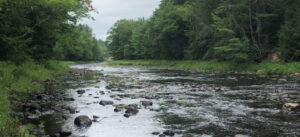Stakeholders, Earth Scientists, Designers and Planners Can Shape the Dynamics of River Restoration

Institution: University of Maine
Sponsor: Water Resources Research Institute (104b) (2021)
Project Summary
A research team studies how added river structures made from natural materials can help restore crucial habitat for endangered Atlantic salmon and other aquatic life in the Narraguagus River, Washington County, Maine.
More than a century of logging and other industrial practices have led to substantial freshwater habitat alterations in Maine streams and rivers. Boulders, downed trees, side channels through floodplains, and other natural features were perceived as obstacles and removed to form wide, straightened channels with rapid flow conditions that once efficiently transported logs to downriver mills.
Though these alterations contributed to some local economic prosperity in the 1800s to mid-1900s, they also damaged suitable habitat for many fish species and other aquatic organisms, cascading negative impacts into freshwater and marine ecosystems. Atlantic salmon are just one of several native species that have experienced population declines and loss of biodiversity due in part to habitat alterations; the Gulf of Maine Distinct Population Segment of Atlantic salmon was listed as endangered under the Endangered Species Act in 2000. The Narraguagus River in Washington County, Maine, was once a trophy salmon river and is now a prime example of how earlier habitat alterations can affect salmon and other species today.
Project SHARE is a nonprofit organization that works to restore Atlantic salmon habitat in the Down East rivers region of Maine, primarily in Washington County. Over the last several years the research team has worked collaboratively with Project SHARE, U.S. Fish and Wildlife Service, U.S. Forest Service, Maine Department of Marine Resources, the National Oceanographic and Atmospheric Administration (NOAA), and Connecticut College to develop a restoration plan for a segment of the Narraguagus River that is approximately half a kilometer long and just south of the Route 9 bridge.
Project SHARE is planning to build a series of engineered log jams (ELJs), large wood structures made from local, natural materials such as uprooted trees and rocks that are intended to replicate natural log jams, as well as constructed floodplains and boulder clusters. Research has shown that ELJs can help restore and maintain natural river functions and aquatic/riparian habitat. They are more effective, but also more expensive to build, than simpler options such as boulder clusters and post-assisted log structures (PALS). PALS are small, hand-built log and branch structures that provide habitat and allow additional debris and sediment from the river to accumulate.
River ice can pose an additional challenge in habitat restoration efforts. ELJs were initially developed for use in the restoration of coastal rivers in temperate climates of the Pacific Northwest, where very little river ice occurs. The Narraguagus River experiences substantial ice buildup, and previous PALS added by Project SHARE have been damaged by ice.
River ice and winter flow conditions are major controls of sediment movement in the Narraguagus River, a crucial factor in habitat suitability for many diadromous fish species. River ice affects habitat restoration by influencing sediment transport and altering river structures. It also presents a significant challenge for monitoring river structures and is often studied by a combination of remote monitoring and computer modeling for safety reasons.
Project SHARE has built four boulder clusters in the designated section of the Narraguagus River. The research team’s role is to study the interactions between the boulder clusters and river ice to generate a better understanding of the forces associated with interactions between them and how ice changes the habitat near the clusters. This work will be done using computer software that is readily available, free of charge, and can be run using a desktop computer. The team will also monitor the flow around the boulder clusters to judge how well the computer model represents what is really happening in the river.
The team will share results with biologists who specialize in aquatic habitat and Atlantic salmon research, seek their input on the habitat quality provided by the boulder clusters, and work collaboratively with them to understand how the design might be modified to maximize habitat quality. This information will then be used to improve the final design of ELJs that are scheduled for construction in August 2022.
Research results will be published in a report describing the findings, including how restoration structures can be designed for improved habitat quality and how river ice and spring floods impact river restoration structures and associated habitat. Using the Narraguagus River as a model system, findings from this research can then be used to inform restoration efforts in locations with similar hydrologic conditions in Maine and beyond.
Project Update
The 3D modeling conducted on this project uses a novel, particle-based framework (smoothed particle hydrodynamics) which will be used as a foundation for future modeling work. Traditional 3D hydrodynamic models use a mesh-based framework. Particle-based models have several advantages relative to mesh models, including the ability to model highly dynamic water surfaces and the physics-based movement of solid objects within the fluid, such as floating wood and ice. The modeling to date has, in part, focused on validating particle-based models for use in river restoration. Work completed to date also includes the modeling of ice floes within a river and their interactions with an individual boulder. Future work will include additional, numerical investigations of the hydrodynamics of habitats created by river restoration and the influence of ice on both the hydrodynamics and the forces the ice floes impart on restoration structures, such as boulder clusters and engineered log jams.
Project Lead
- Peter Koons, Professor, School of Earth and Climate Sciences and Climate Change Institute, UMaine
Research Team
- Joseph Zydlewski, U.S. Geological Survey, Maine Cooperative Fish and Wildlife Research Unit and Professor, Department of Wildlife, Fisheries and Conservation Biology, UMaine
- Samuel Roy, Natural Hazards Planner, State of Maine, Department of Defense, Veterans, and Emergency Management
- Mark Jordan, Ph.D. student, Department of Earth and Climate Sciences, UMaine and President, Jordan Environmental
